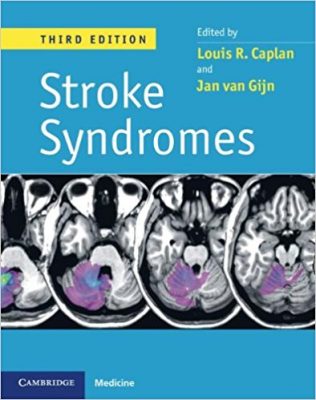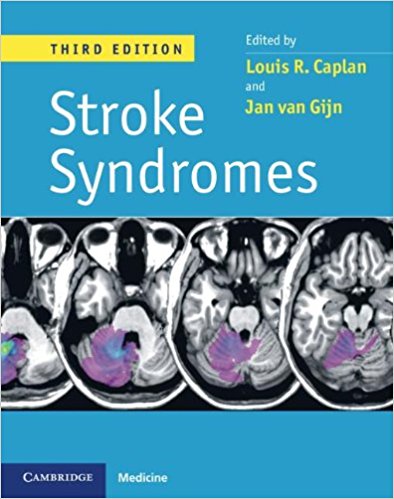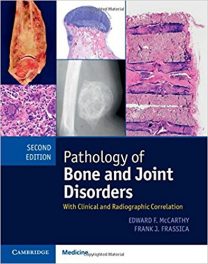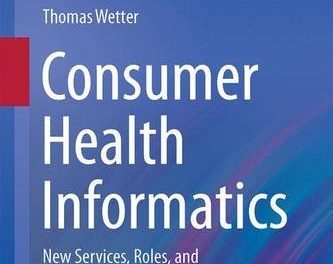 Editors: Louis R. Caplan, MD, and Jan van Gijn, MD
Editors: Louis R. Caplan, MD, and Jan van Gijn, MD
Publisher: Cambridge University Press – 621 pages
Book Review by: Nano Khilnani
This is a companion volume to Uncommon Causes of Stroke, with the same main editor Dr. Louis R. Caplan, That book, whose third edition is expected to be released at the end of July 2018, provides discussions of many of the lesser-known and lesser-recognized causes of stroke, such as various forms of angitis, coagulation disorders, and infective, para-neoplastic and metabolic disorders that may be associated with stroke, and a number of rare syndromes such as Eales disease and Fabry’s disease.
This book Stroke Syndromes, now in its third edition also, presents and discusses many neurologic, neurophysiologic, and other clinical syndromes of stroke. Its contents are organized in such ways to make pattern recognition easier to diagnose, find, and make the right decisions on treatment options. It provides very good, detailed descriptions of problems encountered by stroke victims, both in terms of type and location in the body.
Eighty-two specialists in neurology and the neurological sciences from all over the United States and 12 other countries – Argentina, Australia, Canada, France, Germany, Portugal, South Korea, Spain, the Netherlands, Switzerland, Turkey, and the United Kingdom – authored the 55 chapters of this large book that are grouped into two Sections:
- Section 1. Clinical Manifestations
- Section 2. Vascular Topographic Syndromes
In the first Section, the 28 chapters are organized around abnormalities, aches, behaviors, conditions, disorders, dysfunctions, movements, seizures, symptoms, syndromes, and other manifestations of an unusual nature.
In the second Section, the 27 chapters are more or less about situations that are location-based, such as in the brain and peripheral nerves, in the arteries or veins; in the cerebellum, ganglia, medulla or other parts of the brain; in the areas of the heart, and in different regions in the spine.
So in the first Section – Clinical Manifestations – the chapters pertain to topics such as:
Agitation and delirium; agnosias, apraxias, and callosal disconnection syndromes; aphasia and stroke; auditory disorders in stroke; behavioral and cognitive manifestations of cerebellar stroke; and the cardiac and autonomic manifestations of stroke;
Cerebellar ataxia, cerebral frontal lobe syndromes; coma and abnormal consciousness; dysarthria; eye movement abnormalities, hemiparesis and other types of motor weakness; memory loss; mood disorders; muscle and peripheral nerve manifestations of stroke;
Neurobehavioral aspects of deep hemispheric stroke; seizures and stroke; post-stroke dementia; respiratory dysfunction; visual dysfunction, sensory abnormalities, vertigo and vestibular syndromes, and visual symptoms of stroke.
And in the second Section – Vascular Topographic Syndromes – the chapters pertain to the various locations of strokes, with topics such as:
Anterior cerebral artery; anterior choroidal artery territory strokes; arterial territories of the human brain; basal gangliomic hemorrhages; border-zone infarcts; carotid occlusion syndromes; caudate nucleus infracts and hemorrhages; cerebellar infarcts; cerebral venous thrombosis;
Cervical artery dissections; intracranial arterial dissections; intraventricular hemorrhage; lobar hemorrhages; midbrain infarcts and hematomas; medullary infracts and hemorrhages; multiple bi-hemispheric infarcts; pontime infarcts and hemorrhages; posterior cerebral artery;
Space-occupying supratentorial and infratentorial ischemic stroke; Spinal stroke syndromes; subarachnoid hemorrhage syndromes; syndromes related to large artery thrombi-embolism in the posterior circulation; thalamic infarcts and hemorrhages, and the classical lacunar syndromes;
One of the most common types of stroke is the ischemic stroke, which is caused by a blockage of a blood vessel in the brain, usually caused by thrombosis and emboli from a proximal arterial source or the heart, which leads to the brain being starved of oxygen.
Ischemic stroke, hemorrhagic stroke, and related events are discussed in chapter 5 of this book entitled – Headache in Cerebrovascular Disease – authored by Conrado J. Estol of the Neurological and Vascular Prevention Center in Buenos Aires, Argentina.
Let’s get an overview of this chapter by looking at the outline of topics covered in it:
- Introduction
- Ischemic Stroke
- Transient ischemic attacks
- Embolic arterial disease
- Thrombotic arterial disease
- Hemorrhagic Stroke
- Subarachnoid hemorrhage
- Thunderclap headache
- Intra-cerebral hemorrhage
- Summary of Headache Characteristics in Cerebrovascular Disease (Table 5.1)
- Special Cerebrovascular Disease Scenarios
- Arterial dissections
- Carotid artery revascularization
- Venous and dural sinus disease
- Anti-phospholipid antibodies
- Mitral valve prolapsed
- Patient foramen ovale
- Small vessel Disease
- Cerebral autosomal dominant arteripathy with subcortical infarcts and leukoencephalopathy
- Lacunar disease
- Headache, Migraine, and Stroke
- Vertebro-basilar Migraine
- Conclusions
- References
This is a highly authoritati9ve volume on stroke, with a large number (82 including the two editors) of stroke specialists contributing content to it by authoring or coauthoring its 55 chapters. Strokes are complex events with sometimes multiple types of causes, and its manifestations are many, which can, and have, been missed.
I recommend that all neurologists acquire this most recent (third) edition of this book to enhance their practice.
Editors:
Louis R. Caplan, MD is Senior Neurologist at Beth Israel Deaconess Medical Center, and Professor of Neurology at Harvard Medical School in Boston, Massachusetts.
Jan van Gijn, MD is Emeritus Professor of Neurology and Chairman of the Neurology Department at University Medical Center Utrecht in Utrecht, the Netherlands.







